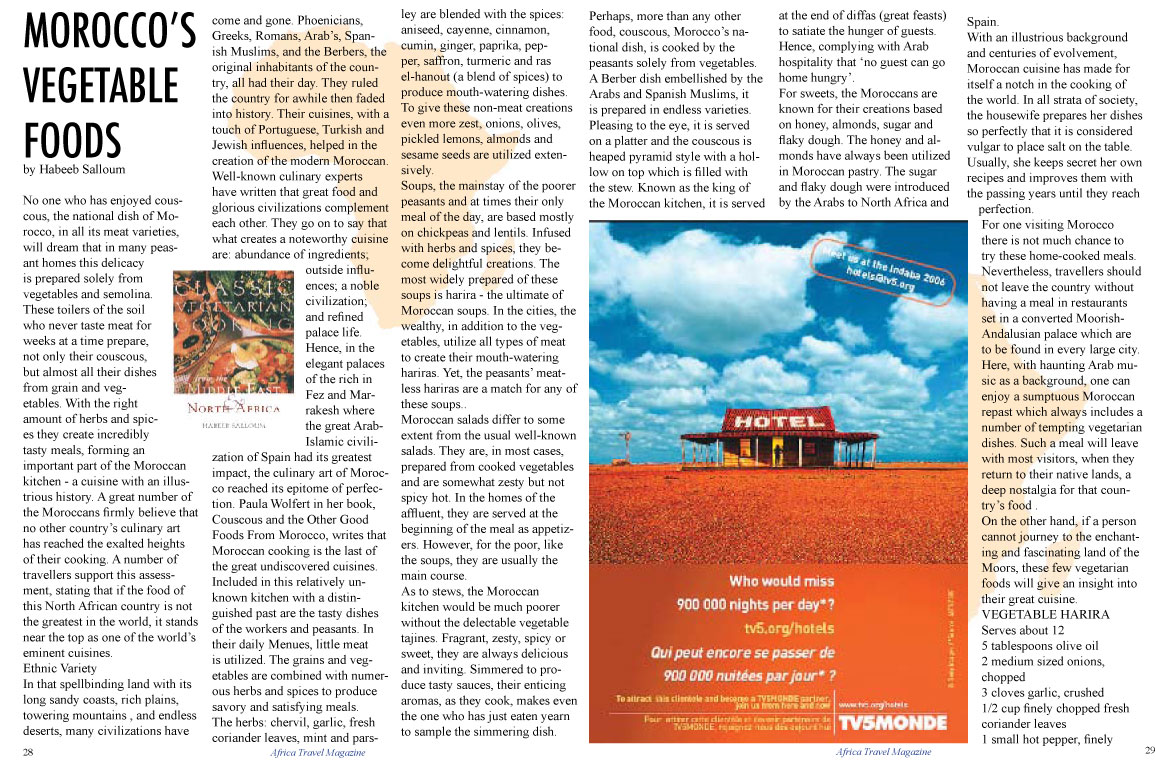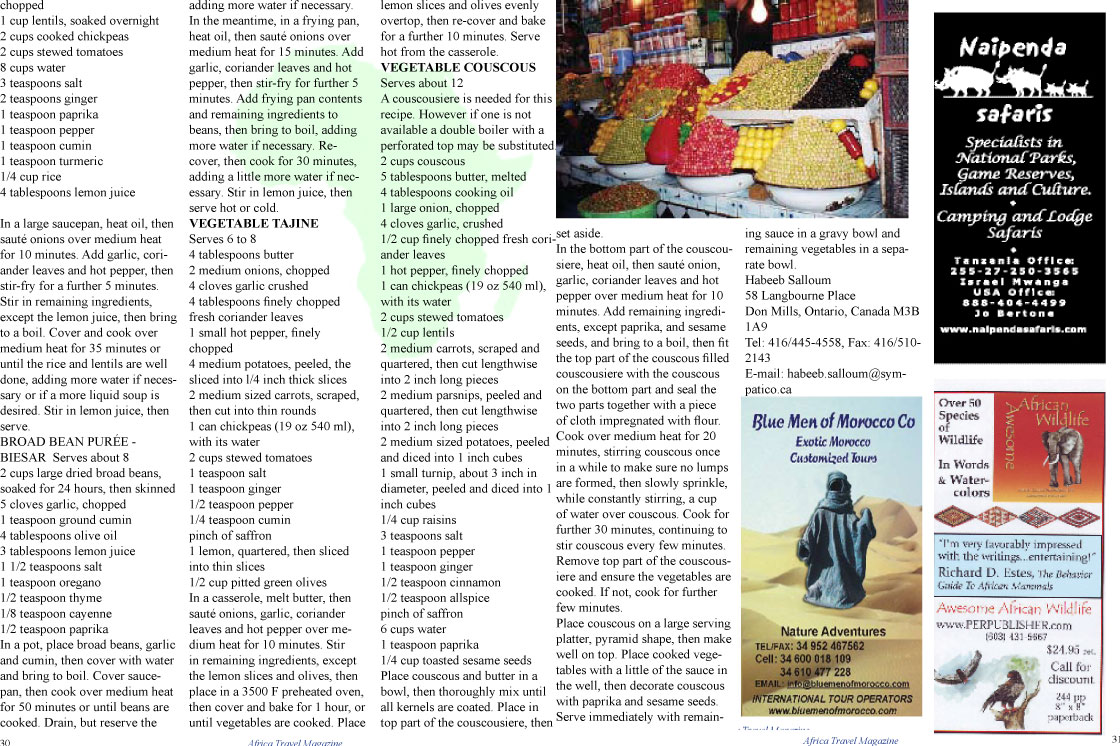|
|
|
by Habeeb Salloum No one who has enjoyed couscous, the
national dish of Morocco, in all its
meat varieties, will dream that in many
peasant homes this delicacy is prepared
solely from vegetables and semolina.
These toilers of the soil who never
taste meat for weeks at a time prepare,
not only their couscous, but almost all
their dishes from grain and vegetables.
With the right amount of herbs and
spices they create incredibly tasty
meals, forming an important part of the
Moroccan kitchen - a cuisine with an
illustrious history. A great number of
the Moroccans firmly believe that no
other country's culinary art has
reached the exalted heights of their
cooking. A number of travellers support
this assessment, stating that if the
food of this North African country is
not the greatest in the world, it
stands near the top as one of the
world's eminent cuisines. Ethnic VarietyIn that spellbinding
land with its long sandy coasts, rich
plains, towering mountains , and
endless deserts, many civilizations
have come and gone. Phoenicians,
Greeks, Romans, Arab's, Spanish
Muslims, and the Berbers, the original
inhabitants of the country, all had
their day. They ruled the country for
awhile then faded into history. Their
cuisines, with a touch of Portuguese,
Turkish and Jewish influences, helped
in the creation of the modern
Moroccan. Well-known culinary experts have
written that great food and glorious
civilizations complement each other.
They go on to say that what creates a
noteworthy cuisine are: abundance of
ingredients; outside influences; a
noble civilization; and refined palace
life. Hence, in the elegant palaces of the
rich in Fez and Marrakesh where the
great Arab-Islamic civilization of
Spain had its greatest impact, the
culinary art of Morocco reached its
epitome of perfection. Paula Wolfert in
her book, Couscous and the Other Good
Foods From Morocco, writes that
Moroccan cooking is the last of the
great undiscovered cuisines. Included in this relatively unknown
kitchen with a distinguished past are
the tasty dishes of the workers and
peasants. In their daily Menues, little
meat is utilized. The grains and
vegetables are combined with numerous
herbs and spices to produce savory and
satisfying meals. The herbs: chervil, garlic, fresh
coriander leaves, mint and parsley are
blended with the spices: aniseed,
cayenne, cinnamon, cumin, ginger,
paprika, pepper, saffron, turmeric and
ras el-hanout (a blend of spices) to
produce mouth-watering dishes. To give
these non-meat creations even more
zest, onions, olives, pickled lemons,
almonds and sesame seeds are utilized
extensively. Soups, the mainstay of the poorer
peasants and at times their only meal
of the day, are based mostly on
chickpeas and lentils. Infused with
herbs and spices, they become
delightful creations. The most widely
prepared of these soups is harira - the
ultimate of Moroccan soups. In the
cities, the wealthy, in addition to the
vegetables, utilize all types of meat
to create their mouth-watering hariras.
Yet, the peasants' meatless hariras are
a match for any of these soups.. Moroccan salads differ to some
extent from the usual well-known
salads. They are, in most cases,
prepared from cooked vegetables and are
somewhat zesty but not spicy hot. In
the homes of the affluent, they are
served at the beginning of the meal as
appetizers. However, for the poor, like
the soups, they are usually the main
course. As to stews, the Moroccan kitchen
would be much poorer without the
delectable vegetable tajines. Fragrant,
zesty, spicy or sweet, they are always
delicious and inviting. Simmered to
produce tasty sauces, their enticing
aromas, as they cook, makes even the
one who has just eaten yearn to sample
the simmering dish. Perhaps, more than any other food,
couscous, Morocco's national dish, is
cooked by the peasants solely from
vegetables. A Berber dish embellished
by the Arabs and Spanish Muslims, it is
prepared in endless varieties. Pleasing
to the eye, it is served on a platter
and the couscous is heaped pyramid
style with a hollow on top which is
filled with the stew. Known as the king
of the Moroccan kitchen, it is served
at the end of diffas (great feasts) to
satiate the hunger of guests. Hence,
complying with Arab hospitality that
'no guest can go home hungry'. For sweets, the Moroccans are known
for their creations based on honey,
almonds, sugar and flaky dough. The
honey and almonds have always been
utilized in Moroccan pastry. The sugar
and flaky dough were introduced by the
Arabs to North Africa and Spain. With an illustrious background and
centuries of evolvement, Moroccan
cuisine has made for itself a notch in
the cooking of the world. In all strata
of society, the housewife prepares her
dishes so perfectly that it is
considered vulgar to place salt on the
table. Usually, she keeps secret her
own recipes and improves them with the
passing years until they reach
perfection. For one visiting Morocco there is
not much chance to try these
home-cooked meals. Nevertheless,
travellers should not leave the country
without having a meal in restaurants
set in a converted Moorish-Andalusian
palace which are to be found in every
large city. Here, with haunting Arab
music as a background, one can enjoy a
sumptuous Moroccan repast which always
includes a number of tempting
vegetarian dishes. Such a meal will
leave with most visitors, when they
return to their native lands, a deep
nostalgia for that country's food . On the other hand, if a person
cannot journey to the enchanting and
fascinating land of the Moors, these
few vegetarian foods will give an
insight into their great cuisine. VEGETABLE HARIRAServes about 12 5 tablespoons olive oil 2 medium sized onions, chopped 3 cloves garlic, crushed 1/2 cup finely chopped fresh
coriander leaves 1 small hot pepper, finely
chopped 1 cup lentils, soaked overnight 2 cups cooked chickpeas 2 cups stewed tomatoes 8 cups water 3 teaspoons salt 2 teaspoons ginger 1 teaspoon paprika 1 teaspoon pepper 1 teaspoon cumin 1 teaspoon turmeric 1/4 cup rice 4 tablespoons lemon juice In a large saucepan, heat oil, then
sauté onions over medium heat
for 10 minutes. Add garlic, coriander
leaves and hot pepper, then stir-fry
for a further 5 minutes. Stir in
remaining ingredients, except the lemon
juice, then bring to a boil. Cover and
cook over medium heat for 35 minutes or
until the rice and lentils are well
done, adding more water if necessary or
if a more liquid soup is desired. Stir
in lemon juice, then serve. BROAD BEAN PURÉE - BIESAR
Serves about 8 2 cups large dried broad beans,
soaked for 24 hours, then skinned 5 cloves garlic, chopped 1 teaspoon ground cumin 4 tablespoons olive oil 3 tablespoons lemon juice 1 1/2 teaspoons salt 1 teaspoon oregano 1/2 teaspoon thyme 1/8 teaspoon cayenne 1/2 teaspoon paprika In a pot, place broad beans, garlic
and cumin, then cover with water and
bring to boil. Cover saucepan, then
cook over medium heat for 50 minutes or
until beans are cooked. Drain, but
reserve the water. Place beans and the remaining
ingredients, except paprika, in a food
processor, then add 1 1/2 cups of the
bottom part of the reserved water with
the sediment and purée. Place purée in a pot, then
heat. Spread on a serving platter, then
decorate with paprika and serve
immediately. EGGPLANT PURÉE - DANJLAL
Serves about 8 1 large eggplant 4 tablespoons olive oil 1 large onion, finely chopped 1 medium sweet green pepper, seeded
and finely chopped 2 tablespoons finely chopped fresh
coriander leaves 2 cloves garlic, crushed 1 1/2 teaspoons salt 1/2 teaspoon pepper 1/2 teaspoon paprika 1/2 teaspoon cumin l/4 teaspoon chili powder 3 tablespoons lemon juice 1 tomato, finely chopped Place eggplant in a 375 F preheated
oven, then bake until skin begins to
blacken and becomes blistery. Remove
and allow to cool. In the meantime, heat oil in a
frying pan, then sauté onion
over medium heat for 10 minutes. Add
the green pepper, then sauté for
further 10 minutes. Peel eggplant, then mash and add,
along with remaining ingredients,
except tomato, to frying pan contents.
Thoroughly mix, then place on a flat
serving plater. Decorate with tomato,
then serve. PARSLEY SALAD - SHLADA MADNOUSSE / Serves from 4 to 6 1 large bunch of wide leaf parsley
(Italian), washed, stemmed and
chopped 2 tablespoons finely chopped fresh
coriander leaves 1 large Spanish onion, finely
chopped 1 medium sweet red pepper, finely
chopped 2 cloves garlic, crushed 3 tablespoons olive oil 3 tablespoons lemon juice 1 teaspoon dried mint 1 teaspoon salt 1/2 teaspoon pepper 1/2 cup black olives, pitted and
halved Place all ingredients, except
olives, in a salad bowl, then
thoroughly mix. Decorate with olives,
then serve immediately. CARROT SALAD - SHLADA DISJADA / Serves 4 to 6 1 pound carrots, scraped, washed,
then sliced into thin rounds 4 cloves garlic, crushed 1 1/2 teaspoons salt 4 tablespoons olive oil 4 tablespoons finely chopped fresh
coriander leaves 3 tablespoons lemon juice 1 teaspoon paprika 1/2 teaspoon cumin l/8 teaspoon chili powder Place carrots, garlic and 1 teaspoon
of the salt in a saucepan, then cover
with water and bring to boil. Cover,
then cook over medium heat for 20
minutes and drain. In a frying pan, heat oil, then
stir-fry carrots over medium heat for
10 minutes or until the carrots are
cooked. In a salad bowl, mix the remaining
ingredients, including the remainder of
the salt. Stir in carrots, then serve
hot or cold. SPINACH SALAD - SHLADA BEGGOULA /
Serves 6 to 8 In Morocco, a mallow called beggoula
is used when preparing this dish.
However, spinach, although not as
tasty, is a good substitute. 2 packages spinach (10 oz 284
g), washed and chopped 1/2 hot pepper, finely chopped 1 teaspoon oregano 4 tablespoons olive oil 2 cloves garlic, crushed 1/2 cup finely chopped fresh
coriander leaves 1 teaspoon salt 1/2 teaspoon pepper 1/2 teaspoon cumin 4 tablespoons lemon juice Place spinach, hot pepper and
oregano in a pot, then cover with water
and bring to boil. Cook over medium heat for 3 minutes,
then remove from heat and drain. In a saucepan, heat oil, then add
spinach and remaining ingredients,
except lemon juice. Stir-fry for 5
minutes, then remove from heat. Stir in
lemon juice, then place on a platter.
Serve hot or cold. ZUCCHINI STEW - AL-GHARA BI TOMATOM / Serves 6 to 8 4 tablespoons olive oil 2 medium onions, chopped 4 cloves garlic, crushed 2
zucchini, 2 zucchini, 8 to 10 inches long,
diced un-peeled into 1 inch cubes 3 medium tomatoes, finely
chopped 1 1/2 cups water 1 teaspoon salt 1 teaspoon ginger 1 teaspoon paprika adding more water if necessary. In the meantime, in a frying pan,
heat oil, then sauté onions over
medium heat for 15 minutes. Add garlic,
coriander leaves and hot pepper, then
stir-fry for further 5 minutes. Add
frying pan contents and remaining
ingredients to beans, then bring to
boil, adding more water if necessary.
Re-cover, then cook for 30 minutes,
adding a little more water if
necessary. Stir in lemon juice, then
serve hot or cold. VEGETABLE TAJINE Serves 6 to 8 4 tablespoons butter 2 medium onions, chopped 4 cloves garlic crushed 4 tablespoons finely chopped fresh
coriander leaves 1 small hot pepper, finely
chopped 4 medium potatoes, peeled, the
sliced into l/4 inch thick slices 2 medium sized carrots, scraped,
then cut into thin rounds 1 can chickpeas (19 oz 540 ml), with
its water 2 cups stewed tomatoes 1 teaspoon salt 1 teaspoon ginger 1/2 teaspoon pepper 1/4 teaspoon cumin pinch of saffron 1 lemon, quartered, then sliced into
thin slices 1/2 cup pitted green olives In a casserole, melt butter, then
sauté onions, garlic, coriander
leaves and hot pepper over medium heat
for 10 minutes. Stir in remaining
ingredients, except the lemon slices
and olives, then place in a 3500 F
preheated oven, then cover and bake for
1 hour, or until vegetables are cooked.
Place lemon slices and olives evenly
overtop, then re-cover and bake for a
further 10 minutes. Serve hot from the
casserole. VEGETABLE COUSCOUS Serves about 12 A couscousiere is needed for this
recipe. However if one is not available
a double boiler with a perforated top
may be substituted. 2 cups couscous 5 tablespoons butter, melted 4 tablespoons cooking oil 1 large onion, chopped 4 cloves garlic, crushed 1/2 cup finely chopped fresh
coriander leaves 1 hot pepper, finely chopped 1 can chickpeas (19 oz 540 ml), with
its water 2 cups stewed tomatoes 1/2 cup lentils 2 medium carrots, scraped and
quartered, then cut lengthwise into 2
inch long pieces 2 medium parsnips, peeled and
quartered, then cut lengthwise into 2
inch long pieces 2 medium sized potatoes, peeled and
diced into 1 inch cubes 1 small turnip, about 3 inch in
diameter, peeled and diced into 1 inch
cubes 1/4 cup raisins 3 teaspoons salt 1 teaspoon pepper 1 teaspoon ginger 1/2 teaspoon cinnamon 1/2 teaspoon allspice pinch of saffron 6 cups water 1 teaspoon paprika 1/4 cup toasted sesame seeds Place couscous and butter in a bowl,
then thoroughly mix until all kernels
are coated. Place in top part of the
couscousiere, then set aside. In the bottom part of the
couscousiere, heat oil, then
sauté onion, garlic, coriander
leaves and hot pepper over medium heat
for 10 minutes. Add remaining
ingredients, except paprika, and sesame
seeds, and bring to a boil, then fit
the top part of the couscous filled
couscousiere with the couscous on the
bottom part and seal the two parts
together with a piece of cloth
impregnated with flour. Cook over
medium heat for 20 minutes, stirring
couscous once in a while to make sure
no lumps are formed, then slowly
sprinkle, while constantly stirring, a
cup of water over couscous. Cook for
further 30 minutes, continuing to stir
couscous every few minutes. Remove top
part of the couscousiere and ensure the
vegetables are cooked. If not, cook for
further few minutes. Place couscous on a large serving
platter, pyramid shape, then make well
on top. Place cooked vegetables with a
little of the sauce in the well, then
decorate couscous with paprika and
sesame seeds. Serve immediately with
remaining sauce in a gravy bowl and
remaining vegetables in a separate
bowl. Habeeb Salloum 58 Langbourne Place Don Mills, Ontario, Canada M3B
1A9 Tel: 416/445-4558, Fax:
416/510-2143 E-mail:
habeeb.salloum@sympatico.ca


MOROCCO'S VEGETABLE FOODS
